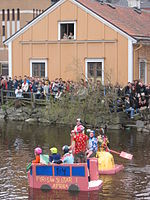Uppsala Mosque
Buildings and structures in UppsalaEuropean mosque stubsMosque buildings with domesMosques in SwedenSwedish religious building and structure stubs

The Uppsala Mosque (Swedish: Uppsala Moské) is a small but very frequented mosque located in the Kvarngärdet neighbourhood of Uppsala in Sweden. At the time of construction, it was mistakenly claimed to be the northernmost mosque in the world (Saint Petersburg was). It is still the northernmost mosque in Sweden. There is another small mosque in Uppsala, located at Bandstolsvägen 28, near Gottsunda centrum. However, Friday Prayer doesn't get offered at this mosque.
Excerpt from the Wikipedia article Uppsala Mosque (License: CC BY-SA 3.0, Authors, Images).Uppsala Mosque
Vattholmavägen, Uppsala Kapellgärdet
Geographical coordinates (GPS) Address Phone number Website External links Nearby Places Show on map
Geographical coordinates (GPS)
| Latitude | Longitude |
|---|---|
| N 59.874025 ° | E 17.638158333333 ° |
Address
Uppsala moské
Vattholmavägen 11
754 19 Uppsala, Kapellgärdet
Sweden
Open on Google Maps










